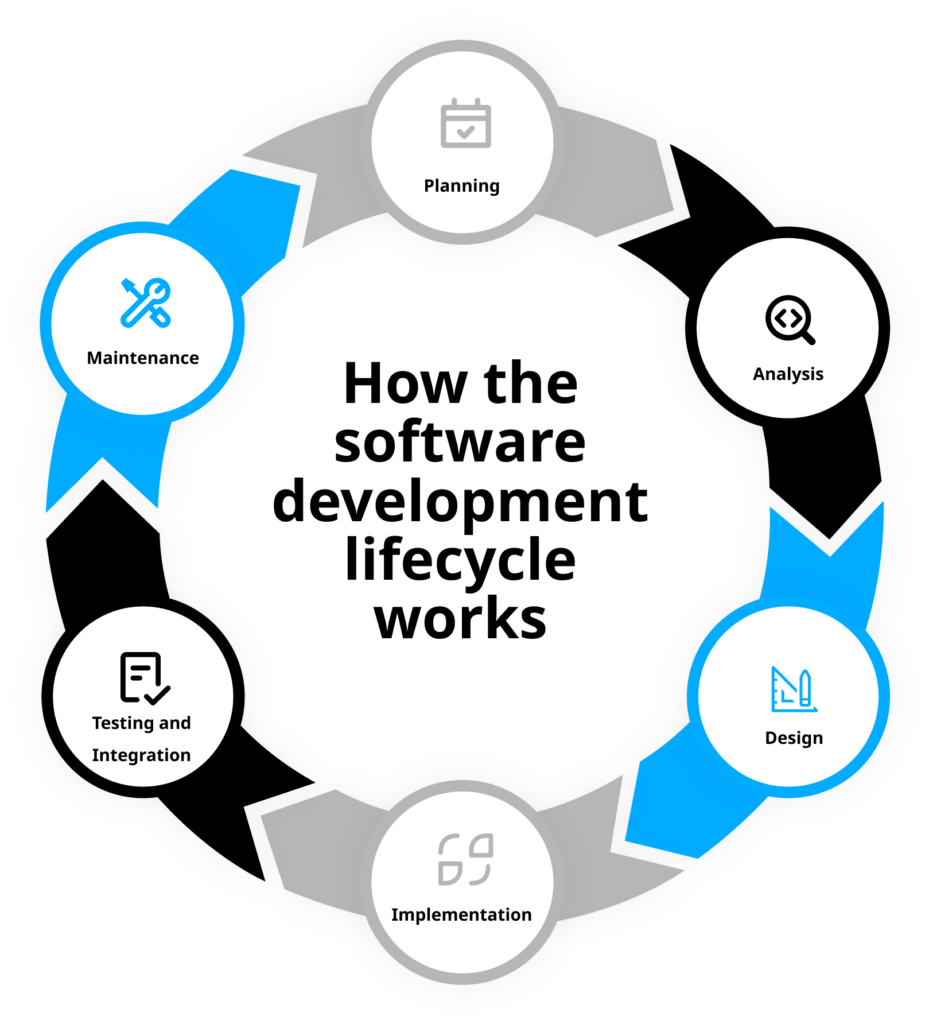Azure DevOps is a tool that can help you manage your software development project more efficiently. It covers all stages of the development process and is designed to make collaboration and automation easy. Discover how it can transform your project management and make your life easier.
What is Azure DevOps?
Azure DevOps encourages a culture of collaboration and a set of procedures that unite developers, project managers, and contributors for software development. It allows organizations to enhance and produce products more rapidly compared to conventional software development methods.

Whether working in the cloud through Azure DevOps Services or on-premises with Azure DevOps Server, it provides integrated features accessible through a web browser or IDE client.
Azure DevOps serves as a comprehensive software development platform with a range of capabilities designed to streamline and speed up development activities throughout the entire application lifecycle. These capabilities include:
- Requirements management.
- Project management catering to both Agile software development and waterfall teams.
- Version control options using either Team Foundation Version Control (TFVC) or Git.
- Automated builds.
- Reporting functionalities, covering test results and development metrics like backlogs and release velocity.
- Testing and release management.
Azure DevOps is optimized for use with native development environments such as Microsoft Visual Studio and Eclipse, although it can also function as a backend for other popular integrated development environments (IDEs).

Why Azure DevOps?
The Azure DevOps software development platform provides tools to support development efforts throughout the entire application lifecycle.
Here are the three major reason behind the effectivesness of the platform:
- Flexibility:
Azure DevOps offers flexibility by enabling the standalone use of its services. Moreover, it seamlessly integrates with existing technologies within the organization, facilitating easy adaptation.
- Platform Independence:
Despite being a Microsoft product, Azure DevOps doesn’t limit itself to Microsoft-created platforms and languages. It is designed to operate on any operating system, including Linux, Windows, and macOS, and with any programming language, such as .Net, Java, PHP, Python, C, C++, iOS, and NodeJS.
- Cloud Independence:
In addition to Azure, the Continuous Integration and Delivery model of Azure DevOps supports other major cloud platforms like Amazon Web Services (AWS) and Google Cloud Platform (GCP).
Azure DevOps Services
Despite being officially launched in October 2018, Azure DevOps is not a novice in the world of DevOps. Its roots can be traced back to the 2006 release of Visual Studio Team System. With over 80,000 Microsoft internal users, this well-established application boasts rich features.
Azure DevOps presents a suite of specialized services, each addressing a crucial aspect of the development lifecycle.

Azure Boards, dedicated to project management, is a scalable service that monitors the team’s work using Agile and Scrum methodologies, Kanban boards, project backlogs, customized reporting and issue tracking, and team dashboards.
For instance, developers can use Azure Boards to:
- – Track user stories, bugs, and features.
- – Utilize interactive backlogs, boards, lists, and calendar views.
- – Generate item worklists and charts.
- – Formulate delivery plans that account for dependencies.
- – Establish connections with GitHub repositories to link GitHub commits, pull requests, and issues.
Azure DevOps Features
It ensures end-to-end traceability, allowing developers to monitor work from requirements through deployment across the entire lifecycle.
Azure Pipelines is dedicated to delivery, integration, and deployment management. This service automates the building and testing of code in major languages, such as Node.js, Python, Ruby, Java, PHP, C#, C++, Go, Xcode, .NET, Android, and iOS.

It supports various project types and amalgamates continuous integration, continuous testing, and continuous delivery, facilitating the building, testing, and delivery of code to a designated deployment target.
Azure Pipelines can accommodate up to 10 parallel jobs in any open-source project. It also provides file transforms and variable substitutions applicable to web app files, as well as Extensible Markup Language and JavaScript Object Notation files. Integration with Git and Azure Repos for version control is seamlessly supported by Azure Pipelines.
Azure Repos, another component, focuses on version control. It comprises a set of version control tools designed to manage and track changes to code over time. This version control system offers a robust mechanism for saving work and coordinating code changes across an entire team.
Azure Repos supplies a private Git repository or Team Foundation Version Control (TFVC), featuring functionalities like collaborative pull requests and advanced file management. Azure Repos integrates with various development environments, including Visual Studio Code, Visual Studio, Xcode, Eclipse, and IntelliJ.
Additionally, Azure Repos can isolate code forks and implement policies to safeguard critical code branches from unauthorized changes.
Test Plans
Azure Test Plans, dedicated to testing, equips developers with tools to enhance code quality and collaboration throughout the development process. Its browser-based test management offers capabilities for planned manual testing, user acceptance testing, exploratory testing, and gathering feedback from project stakeholders. The testing features include:
- Test plans.
- Progress reports.
- Parameters.
- Configurations.
- Runs.
- Test tools.
Azure Artifacts focuses on component management and sharing. This service empowers developers to package and share code efficiently. Developers can publish packages to a feed and then distribute them within the team, across organizations, or publicly.
Furthermore, developers can access and utilize code packages from other feeds or public registries like NuGet.org or npmjs.com. Artifacts supports multiple package types, including NuGet, Npm, Python, Maven, and Universal Packages.
Azure DevOps extensibility
This is a versatile platform that easily adapts to diverse applications, irrespective of frameworks, platforms, or cloud environments. Comprising five services that can be used independently or collaboratively, it accommodates Windows, Mac OS, and Linux environments.
Supporting workflows for native container functionalities, Kubernetes deployment, virtual machines, and serverless setups, Azure DevOps excels in flexibility.
An integral feature is its seamless integration with popular services like Campfire, Slack, Trello, and UserVoice. Users can develop custom extensions to suit unique needs and tailor Azure DevOps based on organizational requirements.
For instance, hosting code on GitHub allows users to exclusively leverage Azure Pipeline for building and deploying.
The platform effortlessly syncs with Azure DevOps Server via an API, enabling efficient item management and version control. Integration with Microsoft Power BI enhances reporting capabilities, offering access to Azure DevOps Analytics for informed decision-making.
Azure DevOps supports automated load testing on web or Windows-based applications through a separately licensed Team Test Load Agent, facilitating performance testing tracking across development cycles.
Who uses Azure DevOps?
Azure DevOps is used predominantly by individuals in the following four roles:
1: Analytics
- Analysts use the tools and services provided by Azure DevOps to input and document work items.
- Azure DevOps enables analysts to create and customize the complexity of documentation, establish templates for streamlined processes, and record information in Hypertext Markup Language (HTML) format, including images and other files.
2: Software Testers
- Software testers leverage Azure DevOps for inputting test scripts and managing acceptance tests.
- The advanced reporting capabilities in Azure DevOps allow testers to track all tests conducted over time.
3. Programmers
- Programmers make use of Azure DevOps for integrated unit testing, source control, and automated builds.
- While Azure DevOps isn’t a development environment on its own, it seamlessly interfaces with Microsoft Visual Studio, enabling programmers to develop using the tools provided by Visual Studio.
4. IT Project and Team Managers, and Other Project Stakeholders
- IT project and team managers, along with other project stakeholders, utilize Azure DevOps to monitor team performance and project progress.
- Large projects can be divided into smaller iterations, work items can be scheduled, and tasks can be assigned to team members through Azure DevOps.
- Team members can update their progress using Azure DevOps, facilitating project and team managers in tracking progress and performance.
- Azure DevOps can also automate the production of various reports, such as product backlogs, burndown charts, and Kanban boards.
Azure DevOps Services and Tools
Azure Boards:
Boards provides interactive and customizable tools designed to assist developers in managing software development projects effectively. It encompasses a range of capabilities, including an easily configurable dashboard, calendar views, integrated reporting, and inherent support for Scrum, Kanban, and Agile processes.
Azure Repos:
Azure Repos serves as a version control toolkit, aiding teams in the management of their application code. Version control is a valuable asset for all software development projects, ideally implemented early in the process, regardless of project size.
A version control system is a software tool that assists users in tracking changes made to an application’s code over time. It captures snapshots of files whenever a developer makes edits to the code, preserving these snapshots in a permanent record.

Version control systems enable teams to synchronize their code changes and retrieve specific changes as needed.
Azure Pipelines:
Azure Pipelines automates the building and testing of code, making it accessible to various projects. It is compatible with most languages and project types, offering integrated continuous integration and continuous delivery (CI/CD) pipelines.
These pipelines facilitate the building, testing, and deployment of code to a designated target. The implementation of a CI/CD pipeline ensures the delivery of high-quality and consistent code, readily accessible to team members.
Azure Pipelines provides a fast, secure, and user-friendly solution for automating the building process, supporting all languages and platforms. It seamlessly integrates with GitHub and Azure deployments, allowing deployment to multiple targets simultaneously.
Azure Pipelines is particularly well-suited for open source development projects, offering compatibility with Linux, Mac, and Windows machines.
Azure Test Plans:
The Test Plans offers intuitive tools that empower team members to enhance code quality and foster collaboration throughout the software development process. This browser-driven test management platform supports planning and executing both manual and automated tests, encompassing user acceptance and exploratory testing.
It also facilitates the collection of feedback from relevant stakeholders, contributing to improved testing practices and software quality.
Azure Artifacts:
Azure Artifacts provides a unified platform for development teams to efficiently share and manage code using controlled software packages. Developers can utilize Azure Artifacts to publish packages to feeds, sharing them within a team, across the organization, or publicly.
The platform allows the consumption of packages from various public registries such as NuGet.org and npmjs.com. Supporting a range of package types, including npm, NuGet, Maven, and Python, Azure Artifacts streamlines the code-sharing process within development teams.
Azure DevOps Licensing Strategy:
For users within an organization requiring access to Azure DevOps, the following access-level licenses are assigned:
1. Stake Holder:
- Free access level with limited functionality.
- Includes access to Azure Boards with partial access, but no access to Azure Repos.
2. Basic:
- – Every organization receives five free basic licenses.
- – Provides full access to Azure Boards, Azure Repos, and Azure Pipelines, but no access to Test Plans.
3. Basic + Test Plans:
- Available as a paid option, with a free trial period of 30 days.
- Offers full access to Azure Boards, Azure Repos, Azure Pipelines, and Test Plans.
4. Visual Studio:
- Users with a Visual Studio subscription incur no additional charges.
- Provides access levels equivalent to Basic + Test Plans.
- Visual Studio subscribers are automatically detected upon signing in.
This licensing strategy allows organizations to choose the level of access that aligns with their needs, providing a balance between free and paid options based on the features required.
Azure DevOps Best Practices:
To maximize the benefits of Azure DevOps, consider the following best practices:
1. Set Up the Project Teams:
- Leverage Azure Boards tools to assist each team in planning and tracking progress.
- Define default teams for each project and support feature-specific teams to ensure independent operation and collaboration.
2. Set Up Sprints:
- Use sprints, specified through Iteration Paths, to define the project’s sprint cadence (typically one to four weeks).
- Sprints can support hierarchies, including release pipelines, and each sprint should represent an assignment a team must deliver by a specified deadline.
- Establish realistic sprint cadences with a minimum of six iterations for a comprehensive plan.
3. Support Searches and Filtering with Tags:
- Enable project teams to assign ad hoc work-item tags for querying, filtering boards, and backlogs based on tags.
- Implement policies guiding the use of tags, providing general usage guidance, supporting filtering, reporting, and identifying cross-team dependencies.
4. Review the Features Board:
- Utilize the Features board to review project progress and ensure a continuous flow of deliverables.
- Customize the Features board to include relevant columns, such as “In Progress,” to represent natural states during design, development, and deployment.
- Configure project delivery plans for multiple teams to review features for shared projects via an interactive board.
- Customize the Features board to accommodate team-specific processes, and use filters to focus on tagged items based on features, specific sprints, etc.
- Incorporate rollup columns to monitor the overall progress of a project.
[Want to learn more about Azure DevOps and its importance in your business? Click here to reach us.]
Conclusion
In summary, Azure DevOps is a comprehensive platform that streamlines the software development lifecycle. With services like Azure Boards, Repos, Pipelines, Test Plans, and Artifacts, it offers versatile solutions for project planning, version control, and continuous integration.
Its flexibility, extensibility, and various licensing options make it adaptable to diverse organizational needs. Azure DevOps encourages collaboration and efficiency, making it a pivotal tool for modern software development, supporting teams in delivering high-quality software with agility. With the help of an expert team in DevOps such as Bobcares, you can easily leverage the amazing tool to maximum for your business.
BoardsPREVENT YOUR SERVER FROM CRASHING!
Never again lose customers to poor server speed! Let us help you.
Our server experts will monitor & maintain your server 24/7 so that it remains lightning fast and secure.








0 Comments